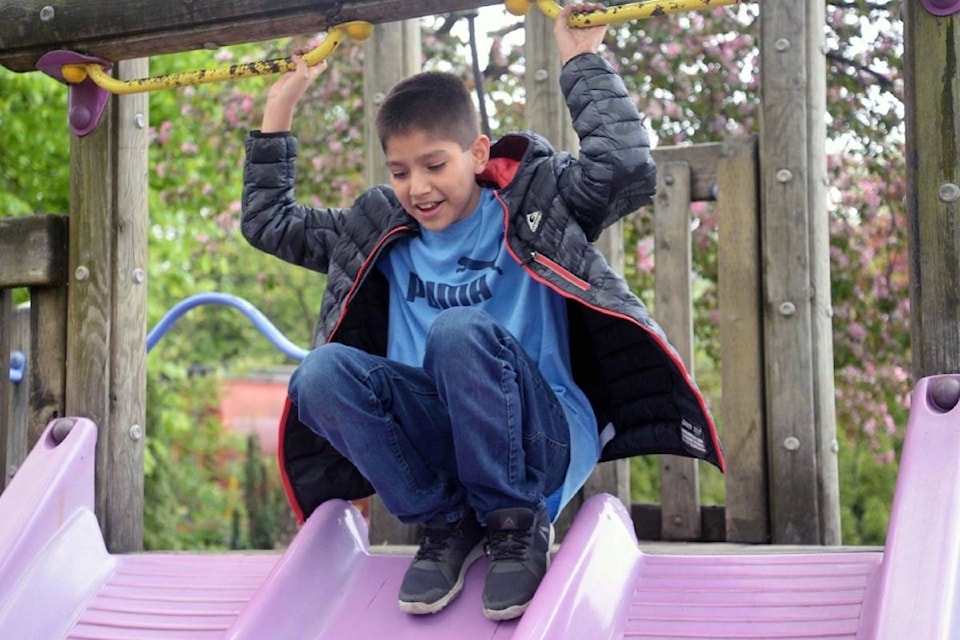Carter Billy is hanging from the monkey bars in Pioneer Park, swinging his legs back and fourth with a wide smile on his face. He’s doing what hundreds of local kids do every spring: soaking up the warm weather with care-free play time in the sun.
It’s hard to believe that only a year ago, the 11-year-old Seabird Island boy was often bed-bound, sometimes in excruciating pain, from what was (then) undiagnosed Juvenile Idiopathic Arthritis (JIA).
JIA is an autoinflammatory disease effecting about one in 1,000 children and teenagers in Canada – making it one of the most common chronic childhood diseases. Arthritis causes a membrane that lines joints to become inflamed, creating a fluid. Joints can become stiff, swollen, painful and warm to the touch.
Carter’s parents watch him play from a nearby bench, still awed by the physical and emotional changes in their son.
Back in early 2017, Carter’s debilitating symptoms had peaked. He was often so exhausted that he was unable to focus in school and would sometimes fall asleep at the dinner table even after 10-12 hours of sleep a night.
Mom Jenny Billy recalls the frustration of watching Carter struggle on a day to day basis, unable to find answers or help him get better. He couldn’t do the things that he wanted to, like bike or kayak. Billy remembered how Carter broke down into tears after only a few minutes on a family bike ride.
“It seemed like we were just dragging him, we were torturing him,” she recalled. “Most [kids;] you can’t get them off their bikes…and we couldn’t get him on the bike.”
“It was very frustrating in the beginning.”
JIA isn’t easy to treat. There are multiple different types, and different children respond differently to medications. Fortunately for Carter, it took one year until doctors had found a combination of anti-inflammatory, disease-modifying and biologic medications, usually used on adults – that helped him make major improvements.
As Carter grins from the top of a slide, leaping down and running to the near-by wooden ladder, it’s clear that he’s a different kid today than he was one year ago.
Carter started riding his bike, using a scooter, playing board games and even beading – the results of which his mother wears proudly in her ears: blue and white beaded earrings that read, ‘Keep Calm and Bead On.’
“I feel different, I don’t feel as ache-y,” Carter said during a quick break from the playground. “I don’t have to lie in bed all day long. I don’t have to stand up in the middle of class now.”
Billy agrees. “I get more ‘yes’s’ now,” she said, recalling how Carter recently helped her paint the family’s living room.
“He came to help me roll the paint. And I’m looking at him, I’m watching his little wrists and arms and elbows go up and down the wall.”
“Even the doctors are shocked and surprised every time we show up,” she added.
A growing problem
Carter will always live with the possibility of chronic pain looming over him. But for now, the treatment has been life changing. Unfortunately there are children who may not see the same results, or get the opportunity for diagnosis or treatment.
Dr. Houghton explained that untreated arthritis not only impacts a child’s day to day life, but can have long-term impacts.
“In the short-term we worry about kids’ pain and mobility, and their ability to function and participate in age-appropriate activities including fun things like play and sport,” she said. “In the long-term, if arthritis goes untreated…we worry about actual damage to the joints, which in a growing child can lead to growth deformity.”
Arthritis, in adults and children, disproportionately impacts Canadians of First Nations descent, living both on and off reserves.
Data from the Canadian government estimates the prevalence of arthritis in First Nations people to be about 1.6 times higher than the national estimate in the Canadian adult population.
And about two thirds of First Nations people reporting arthritis are young – between 30 and 59-years-old.
Houghton said there’s no concrete data to back up claims that JIA is more prevalent in Indigenous children, but there is growing evidence that children of First Nations descent are at a higher risk of developing the disease.
Taking the next steps
Carter is wiser and more empathetic because of the disease, his parents said.
In fact, it was his idea to share his story, so that other kids with chronic pain would know they aren’t alone.
“At first, I felt alone when I found out,” he said. “I felt aching pains, sometimes nearly all day. And once I found out I wasn’t alone, I thought, ‘I’m not alone, yay!’
“That’s the reason why I’m doing this.”
Last year, the Billys’ participated in Cassie and Friends Family Day event, where they heard from speakers on JIA and met other families and kids dealing with the disease. This year Carter is strong enough to fundraise for and participate in the organization’s five-kilometre half marathon on June 24 at Stanley Park. The run gives 100 per cent of dollars raised to research, child and family support and educational events. Visit cassieandfriends.ca to find out how you can join or support the cause.
